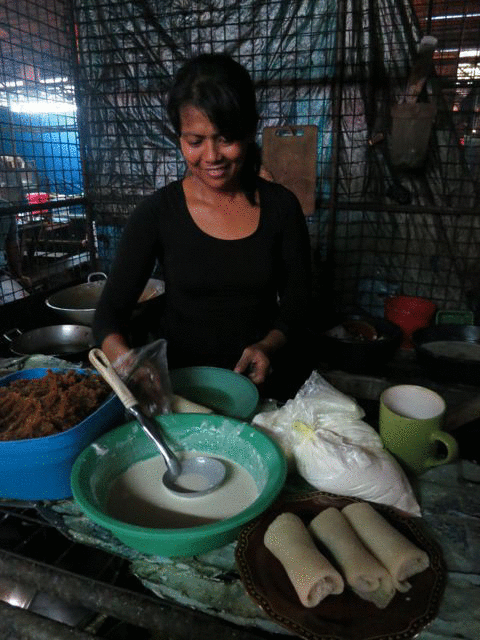My friend, Cathy saw these bunches of this fruit on the table and asked if we were interested in eating it. She said it is one of her favorite fruits!
Do you recognize this purple fruit?
Well, some may immediately recognize it as the mangosteen! But others may not have seen it ever.
Funny that its name has the Mango- prefix, where in fact, Mango is in no way related to the Mangosteen fruit!
For those not so familiar with this fruit, I would just like to share some things about it...
Here is what I gathered from Wikipedia...
The purple mangosteen(Garcinia
mangostana), colloquially known simply as mangosteen, is a
tropical evergreen tree believed to have originated in the Sunda Islands and
the Moluccas of Indonesia.
The tree grows from 6 to 25 m (20–82 ft)
tall.[1] The fruit of the
mangosteen is sweet and tangy, juicy, and somewhat fibrous, with an inedible,
deep reddish-purple colored rind (exocarp) when ripe. In each
fruit, the fragrant edible flesh that surrounds each seed is botanicallyendocarp, i.e.,
the inner layer of the ovary.[2][3]
The edible endocarp of the mangosteen is botanically defined as
an aril with the same shape and size as a tangerine 4–6 centimetres in
diameter, but is white. The circle of wedge-shaped arils contains 4–8, rarely 9.
Mangosteen peel contains xanthonoids, such as mangostin, and
other phytochemicals having antioxidant properties in vitro.
 |
| note the thick exocarp with the aril within Wikipedia: The aril is the white part of the fruit containing a mild flavor that makes the fruit popular for eating; when analyzed specifically for its nutrient content, the mangosteen aril is absent of important nutrient content |
 |
| Wikipedia: On the bottom of the exocarp, raised ridges (remnants of the stigma), arranged like spokes of a wheel, correspond to the number of aril sections. |
 |
| And this was taken in a fruit stall in Bangkok where we have varied colors of mangosteen and the "leaf-like" toppings look so thick. |
Also BE WARY! of the Mangosteen seeds. I personally know of two people who swallowed the seeds and ended up operated for Intestinal Obstruction!
Also beware of Santol seeds who has its own set of victims for operation!
What do you think of Lanzones seeds...aren't they of the same size?
By the way, why do people swallow the seeds in the first place?























